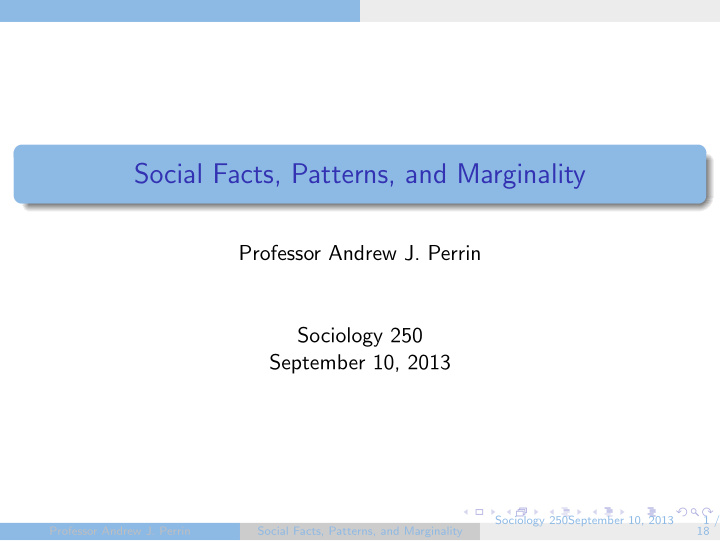



Social Facts, Patterns, and Marginality Professor Andrew J. Perrin Sociology 250 September 10, 2013 Sociology 250September 10, 2013 1 / Professor Andrew J. Perrin Social Facts, Patterns, and Marginality 18
Outline 1 du Bois and Durkheim, through Fields 2 Critical Distance and Objectivity 3 Social Facts and Social Problems 4 Bonilla-Silva, “Racism Without Racists” 5 Georg Simmel Sociology 250September 10, 2013 2 / Professor Andrew J. Perrin Social Facts, Patterns, and Marginality 18
duBois as a General Social Theorist Durkheim finds in “the Negro” of Souls an unwarranted particularism. Du Bois finds in the qualit´ e d’homme of “Individualism” an unwarrantable generality. —Fields, 437 Sociology 250September 10, 2013 3 / Professor Andrew J. Perrin Social Facts, Patterns, and Marginality 18
Critical Distance ...they would have had much to say to one another about the complexities and the perplexities of living out one’s own creative intellectual life amid the constraints of having not one but two pregnant identifications: in Durkheim’s case, French and Jew; in Du Bois’s, American and Afro-American. —Fields, 440 Sociology 250September 10, 2013 4 / Professor Andrew J. Perrin Social Facts, Patterns, and Marginality 18
Big Question How is it that humans come to hold on to beliefs about cosmic nature that cannot possibly be true — and that, besides, cosmic nature unceasingly contradicts? He finds the answer in their social being, which is also the course of the most fundamental human capacity: reason itself. ... Durkheim studies the collective alchemy by which reason converts bald-faced inventions into external and constraining facts of nature, capable of resisting individual doubt. —Frields, 438 Sociology 250September 10, 2013 5 / Professor Andrew J. Perrin Social Facts, Patterns, and Marginality 18
Marginality and Intellectuals Sociology 250September 10, 2013 6 / Professor Andrew J. Perrin Social Facts, Patterns, and Marginality 18
Critical Distance The Irony Sociology 250September 10, 2013 7 / Professor Andrew J. Perrin Social Facts, Patterns, and Marginality 18
Social Facts, Social Patterns Exposing what’s obvious Sociology 250September 10, 2013 8 / Professor Andrew J. Perrin Social Facts, Patterns, and Marginality 18
E. Bonilla-Silva, Racism Without Racists Question: Why do we observe racism’s effects in the world, but few people holding racist views? One possibility: “All that is necessary for the triumph of evil is that good men do nothing.” (Edmund Burke) Racism Without Racists: Racism is a social fact patterned but not (mostly) intentional. Sociology 250September 10, 2013 9 / Professor Andrew J. Perrin Social Facts, Patterns, and Marginality 18
Georg Simmel Born 1858, “Heart of Berlin” Died 1918 Very famous in Germany and the US Never really central to the university system Ironically, more important to American than European social theory The “great link” to American sociology Sociology 250September 10, 2013 10 / Professor Andrew J. Perrin Social Facts, Patterns, and Marginality 18
Simmel: View of Society Societal connection immediately occurs in the. . . individuals.. . . Societal unification needs no outside its own component elements, the individuals.. . . Each member of society. . . is absorbed in innumerable, specific relations and in the feeling and knowledge of determining others and being determined by them. “How is Society Possible?” (1908) Sociology 250September 10, 2013 11 / Professor Andrew J. Perrin Social Facts, Patterns, and Marginality 18
View of Society: “Web of Group Affiliations” How is Society possible when people are so individual? What is the relationship between groups (e.g., religions, ethnicities, interests, classes, etc.) and society? Answer: individual and society are dialectically related individuals are constituted by group affiliations modern life (particularly urban) provides enough group affiliations for the net of them to be individually unique Sociology 250September 10, 2013 12 / Professor Andrew J. Perrin Social Facts, Patterns, and Marginality 18
Key Concept: Social Forms . . . a relation, which is a fluctuating, constantly developing life-process, nevertheless receives a relatively stable external form. . . . The form thus comes to constitute a more or less rigid handicap for the relation in its further course, while the form itself is incapable of adapting to the vibrating life and the more or less profound changes of this concrete, reciprocal relation. Sociology 250September 10, 2013 13 / Professor Andrew J. Perrin Social Facts, Patterns, and Marginality 18
Social Forms “The sociologist is concerned with King John, not with King John .” —Coser 1977 (180), on Simmel Sociology 250September 10, 2013 14 / Professor Andrew J. Perrin Social Facts, Patterns, and Marginality 18
Social Forms (Selections) The Stranger The Poor The Miser and the Spendthrift The Adventurer The Nobility Sociology 250September 10, 2013 15 / Professor Andrew J. Perrin Social Facts, Patterns, and Marginality 18
Contemporary Question: Emergence The fundamental unit of human behavior is the group, but... We observe individuals behaving in ways that can’t be predicted by looking just at their groups. How do we explain the relationship between individuals and groups? Sociology 250September 10, 2013 16 / Professor Andrew J. Perrin Social Facts, Patterns, and Marginality 18
Emergence in the natural sciences Sociology 250September 10, 2013 17 / Professor Andrew J. Perrin Social Facts, Patterns, and Marginality 18
Questions of Emergence Brain − → Mind Individual − → Group Sociology 250September 10, 2013 18 / Professor Andrew J. Perrin Social Facts, Patterns, and Marginality 18
Recommend
More recommend